The Texas Ten Percent Plan (TTP) provides students in the top 10 percent of their high-school class with automatic admission to any public university in the state, including the two flagship schools, the University of Texas at Austin and Texas A&M. Texas created the policy in 1997 after a federal appellate court ruled, in Hopwood v. Texas, that the state’s previous affirmative-action system based on racial preferences was unconstitutional. Through the TTP Plan, the state sought to maintain diversity in its most-competitive public universities in a race-neutral way. The program soon became the model for similar policies in Florida and California.
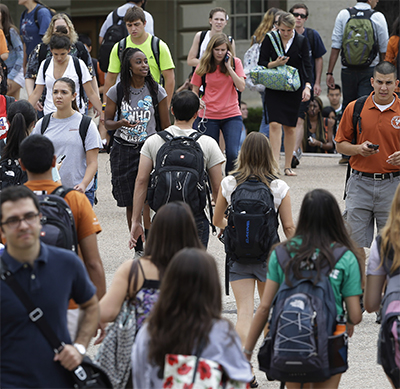
(Photo by Eric Gay/Corbis Images)
Percent plans in Texas and elsewhere have sparked considerable controversy. Some critics allege that they force the most-selective public colleges to admit underprepared students from low-performing schools and to deny admission to better-prepared students; others complain that they don’t do enough to promote diversity. After the Supreme Court upheld some forms of race-conscious affirmative action in 2003, UT-Austin quickly reinstated racial preferences in admissions, triggering a challenge that led to the Supreme Court’s most recent affirmative-action case. In Fisher v. University of Texas at Austin, the Supreme Court in 2013 directed a lower court to consider whether the school’s use of racial preferences is essential to yield sufficient diversity in its student body. The key question the court must address: whether race-neutral methods, such as TTP, could accomplish the same goal.
Often lost in the debate over these policies is a more basic question: do they benefit the students who receive automatic admissions? Given their academic accomplishments, many of the students who gain admission under a percent plan may have been admitted to selective universities in the absence of the plan. But the number of students admitted under such plans has increased over time in Texas, suggesting that the programs have in fact had a sizable effect on enrollments. Additionally, percent plans may not just affect whether students apply to and attend college, but where they apply and matriculate.
In this study, we examine the effect of being eligible for automatic admission under the Texas Ten Percent Plan. We compare students in a large urban school district who just made it into their high-school’s top 10 percent to students who just missed the cutoff. We find that eligibility for automatic admissions under the TTP Plan increases the likelihood that students enroll at a flagship Texas university by at least 60 percent. This increase in flagship enrollment displaces enrollment in private universities, however, and therefore has no effect on overall college enrollment or on the quality of college attended. The effects on flagship enrollment are only observed in high schools that send many of their graduates to college, suggesting that automatic admission may have little effect on the college choices of students in the state’s most-disadvantaged schools.
The Texas Plan
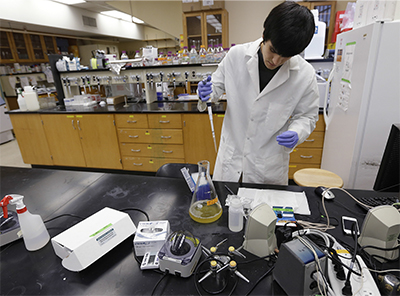
(Photo by Eric Gay/Corbis Images)
The TTP Plan requires that students who are ranked in the top 10 percent of their class be admitted to the Texas public college of their choice. The state grants flexibility to districts in how they choose to calculate grade-point average (GPA) and class rank. To receive automatic admission, students must provide a transcript, along with their application, that verifies that their class rank falls within the top 10 percent. They must also take either the SAT or the ACT, although for students in the top 10 percent of their high-school class, these tests are not used for admissions decisions.
For students not in the top 10 percent of their high-school class, admissions decisions are based on standard criteria, including GPA and class rank, admissions test scores, and nonacademic factors such as personal statements and extracurricular activities. Following the Supreme Court’s 2003 Grutter v. Bollinger decision upholding limited affirmative-action policies in use at the University of Michigan law school, the UT-Austin (but not Texas A&M) reinstated race-conscious affirmative action. The aggressiveness of the new affirmative-action policy, however, is unclear. We are not aware of any research that examines the true extent to which racial preferences are used in the post-Grutter era.
Data
The data for our study come from an unnamed large urban school district in Texas. We focus our analysis on 17,057 graduates from the 2002 through 2008 graduating classes. For each of these students, we have information on demographics, high school attendance, courses taken and grades received each semester, exit-exam scores, and whether they graduated.
Our data do not include the students’ class ranks, so we construct them ourselves following the procedure used by the district. First, we compute cumulative GPA at a given point in time using grades received in courses taken up to that juncture. Second, we rank students within their schools based on cumulative GPA to determine absolute class rank. Finally, we calculate the percentile class rank by dividing absolute class rank by the number of students in a school with a valid cumulative GPA. Our main analysis uses the class rank at the end of 11th grade, which is the criterion most commonly used for automatic admission to UT-Austin and Texas A&M.
Our information on college enrollment comes from the National Student Clearinghouse (NSC), a nonprofit organization that is now the nation’s leading source for postsecondary degree and enrollment verification. The NSC data include, for each semester, observations for each NSC-reporting institution that a student attends, including date of enrollment and completion. We supplement the NSC data with additional information on the institutions students attend from the federal government’s Integrated Postsecondary Education Data System (IPEDS), including whether the institution is public or private and where it is located.
The IPEDS data also enable us to construct measures of college “quality” and cost. Our first quality measure is the Barron’s ranking of how competitive admission is at a particular college, which is available from the National Center for Education Statistics. A second measure of quality is the fraction of applicants who are admitted. We measure cost using the tuition “sticker price” that students face at a particular institution. This is only a proxy for the actual tuition students will have to pay, since many of the students in our sample come from disadvantaged backgrounds and would qualify for substantial financial aid. Nonetheless, because selective institutions generally charge a higher price, tuition provides a general indication of relative school quality.
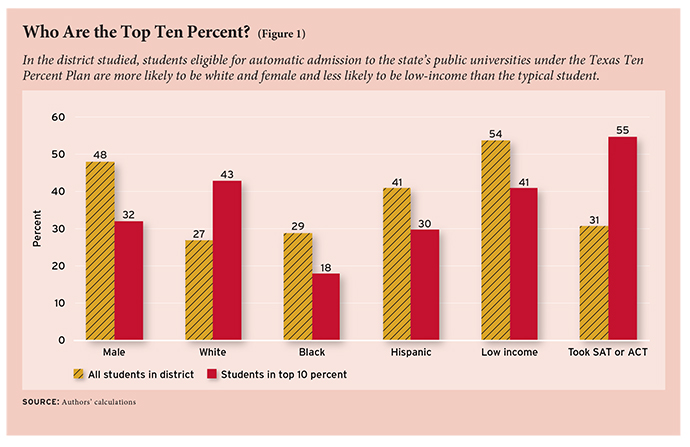 Our data indicate that students in the top 10 percent of their high-school class are more likely to be white and female and less likely to be low-income than their peers (see Figure 1). As expected, students in the top 10 percent are higher-performing across all measures of academic achievement. Students in the top 10 percent are more likely to graduate with a recommended or distinguished diploma, take a college entrance exam, and have much higher high school exit-exam scores than their peers. Fifty-eight percent of students in the top 10 percent enroll in college, compared to just 30 percent of students districtwide, but only 21 percent of the top 10 percent enroll in a Texas flagship (see Figure 2).
Our data indicate that students in the top 10 percent of their high-school class are more likely to be white and female and less likely to be low-income than their peers (see Figure 1). As expected, students in the top 10 percent are higher-performing across all measures of academic achievement. Students in the top 10 percent are more likely to graduate with a recommended or distinguished diploma, take a college entrance exam, and have much higher high school exit-exam scores than their peers. Fifty-eight percent of students in the top 10 percent enroll in college, compared to just 30 percent of students districtwide, but only 21 percent of the top 10 percent enroll in a Texas flagship (see Figure 2).
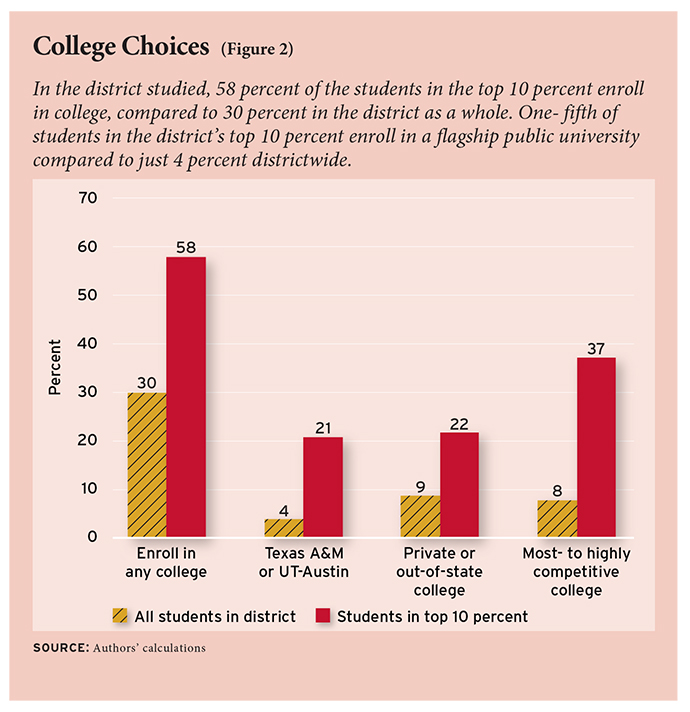
Methods
Our goal is to study the effect of being eligible for automatic admission to the Texas public universities via membership in the top 10 percent of one’s high-school class. The challenge we face is that TTP-eligible and -ineligible students are obviously quite different, most importantly in terms of academic performance. To measure the effect of being in the top 10 percent, we use an approach that mimics random assignment into the top 10 percent. Specifically, our regression discontinuity research design compares the outcomes of students whose class rank is just above or below the cutoff. As long as students cannot exert complete control over their exact class rank, students on either side of the threshold should be similar in all respects other than whether they are in the top 10 percent.
The primary threat to this research design would be if students eager to attend a flagship institution were able to manipulate their class rank in order to end up just above the 10 percent cutoff. Although students may alter the mix of courses they take and petition for better grades in order to increase their chances of being in the top 10 percent of their class, course performance is at least somewhat uncertain and students are unlikely to have precise information about the GPAs of their classmates. This makes it unlikely that students can manipulate their class rank with enough precision to bias our results.
Although eligibility for automatic admission to the Texas public universities is the most noteworthy consequence of being in the top 10 percent, the policy in place in Texas during this time included outreach efforts by the flagships that targeted students in or near the top 10 percent, especially at schools that serve large numbers of disadvantaged students. This outreach may have had independent effects on college enrollment by, for instance, increasing information about college. As such, our results should be interpreted as reflecting the combined effect of automatic admission and the outreach efforts that are part of the TTP Plan.
In addition, our results are specific to students near the eligibility cutoff. In other words, they may not tell us what effect automatic admission would have for students far below or above the 10 percent cutoff. Even so, the effect of the TTP Plan on college outcomes near the eligibility cutoff has considerable policy relevance. The controversy surrounding the plan largely stems from the perception that the law lets “underqualified” students gain admission to the state’s most-selective public universities. Our estimates shed light on the plan’s impact on students for whom this claim is most likely to be relevant: students admitted under the plan in a relatively low-performing urban district. Moreover, our results are informative about the likely consequences of any changes in the TTP cutoff, such as UT-Austin’s fall 2011 decision to limit automatic admissions to 75 percent of the entering class.
Results
We first examine the effect of TTP on college enrollment and college choice in the fall following graduation from high school. Only about 9 percent of students who just miss being in the top 10 percent enroll in a flagship. We find that barely securing membership in the top 10 percent increases flagship enrollment by at least 5 percentage points, with positive effects at both UT-Austin and Texas A&M (see Figure 3). This result implies that program eligibility increases the likelihood of flagship enrollment by almost 60 percent, a very large effect.
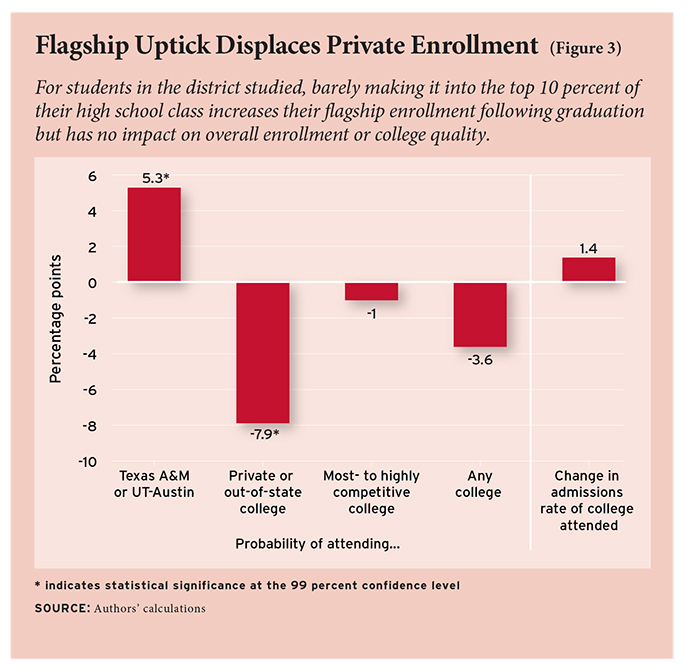 But does this effect on flagship enrollment translate into an overall increase in the likelihood of enrolling in college? We find no evidence that this is the case, suggesting that increased flagship enrollment must be displacing enrollment at some other type of institution. One possibility is that students who enrolled in a flagship because they were eligible for automatic admission would have gone to another university had they missed it. And, indeed, we find that program eligibility sharply reduces enrollment at private or out-of-state colleges.
But does this effect on flagship enrollment translate into an overall increase in the likelihood of enrolling in college? We find no evidence that this is the case, suggesting that increased flagship enrollment must be displacing enrollment at some other type of institution. One possibility is that students who enrolled in a flagship because they were eligible for automatic admission would have gone to another university had they missed it. And, indeed, we find that program eligibility sharply reduces enrollment at private or out-of-state colleges.
Next, we examine whether TTP status affects the quality of the colleges students attend. This is important, because the plan is designed to improve access to elite universities by guaranteeing access to the state’s flagship institutions. Also, much of the opposition to the TTP Plan centers on the claim that students admitted via the TTP Plan’s automatic-admission guarantee will take spots from better-qualified students who are not admitted under the TTP Plan because they attend more-competitive high schools.
To examine this issue, we first calculate the effect of eligibility for automatic admission on the probability of enrolling in a college ranked by Barron’s as a “most” or “highly” competitive institution. We also use a measure of selectivity defined as the fraction of applicants to a college who were admitted. For both measures, we find no clear evidence that program eligibility increases the quality of institutions students attend. We do find some evidence that TTP eligibility leads to attending colleges with lower tuitions, however, as would be expected if students are attending a public flagship instead of a private college.
An important question is whether students who are admitted under the TTP Plan drop out of these highly selective schools at a higher rate than other students. For instance, it may be that students admitted because of TTP are not able to do well in the rigorous academic environment of the flagship universities. However, we found no evidence that being in the top 10 percent affected the likelihood of transferring to a less-selective institution (as measured by the Barron’s competitive admissions ratings) or the probability of dropping out of college.
Finally, we examine whether our results vary for students from different racial and socioeconomic backgrounds and from high schools that send more and less of their graduates to college. We find no consistent evidence that TTP effects are different for underrepresented minority students than for other students. The effects of program eligibility are the same for black and white students. We do, however, find stronger evidence of TTP effects for students who are not economically disadvantaged than for their low-income peers.
When we compare TTP effects at high schools with different college-going rates, we find that the positive effects on flagship enrollment are largest in the schools with relatively high college-going rates (where at least 25 percent of graduates enroll in college in the fall following graduation). At these high schools, being in the top 10 percent increases the flagship enrollment rate by at least 9 percentage points. In contrast, we do not find any evidence of impacts on flagship enrollment for students from high schools with low college-sending rates. When interpreting these results, it is important to remember that even the higher college-sending high schools in the district have relatively low college-sending rates relative to the state as a whole. Nonetheless, eligibility for automatic admission appears to have little effect on college enrollment and choice for the most-disadvantaged urban high schools.
Conclusions

(Photo by MCT/Getty Images)
The difference in earnings between college graduates and nongraduates has risen in recent decades, and research indicates that attending selective colleges yields a larger economic return than attending less-selective institutions. The benefits of attending a selective college appear to be especially large for lower-income black and Hispanic students. Yet disadvantaged and underrepresented minority students attend selective colleges at far lower rates than do higher-income and white students. Devising strategies to close these gaps has considerable significance for social and economic policy.
Yet we find little evidence that the automatic admissions guarantee leads to increases in the quality of the colleges students attend. Instead, the increases in flagship enrollment appear to decrease enrollment at comparably ranked private institutions. Thus, offering eligibility for automatic admission does not appear to increase access to selective colleges in general, even though it increases access to the best public universities in Texas.
Our results demonstrate that eligibility for automatic admission does appear to increase enrollment at flagship universities for students in an urban school district that sends relatively few students to college. In particular, we also find these effects for underrepresented minority students. These findings are noteworthy because a key goal of the TTP Plan, and percent plans in general, is to increase access to top public universities for traditionally underserved populations.
But the effects on flagship enrollment are concentrated in the district’s most-advantaged schools. Indeed, when we calculate effects by the percentage of students at a high school who attend college, we find no evidence of effects on college choice in the schools with the lowest college-sending rates. Although the college-sending rates of the highest-performing high schools in the sample are low relative to Texas as a whole, our findings suggest that offering eligibility for automatic admission may not be effective at accomplishing even the narrow goal of increasing access to the top public universities for students in the most-disadvantaged settings.
There are important questions that our paper does not address. Because we use data from an urban school district, our findings may not reflect how automatic admission guarantees affect students in rural or suburban schools. The effects in rural areas are important because the TTP Plan aims to increase geographic diversity at the state’s public universities. Likewise, the effects in suburban areas have significance because many of the criticisms about the policy’s fairness stem from concerns that it places students in suburban districts at a disadvantage because it is harder for them to get into the top 10 percent. It is nonetheless plausible that the lack of effects on college selectivity that we find may hold in higher-income districts as well, since students in these districts who fall just shy of the top 10 percent likely face fewer informational and financial barriers to enrolling in high-quality colleges absent an automatic admissions guarantee than do students in our sample.
Finally, our results cannot speak to the overall effects of instituting the TTP Plan. These effects might include strategic behavior such as choosing less-competitive high schools to make it easier to get the admission guarantee as well as changes in student effort and course-taking behavior. Determining whether these and other unintended consequences of percent plans exist is an important area for future research. In the meantime, our evidence suggests that although the policy clearly increases the number of eligible students who attend Texas’s top two universities, the program appears to have simply shifted students from selective private or out-of-state colleges to the two flagship universities. That may have lowered educational costs for eligible students, but it did not enhance the quality of their higher education opportunities.
Lindsay Daugherty is associate policy researcher at the RAND Corporation. Paco Martorell is economist at the RAND Corporation and research scholar with the Center for Research on Education Policy at the University of Texas at Dallas’s Texas Schools Project. Isaac McFarlin Jr. is assistant research scientist of public policy at the University of Michigan and research scholar with the Center for Research on Education Policy at the University of Texas at Dallas’s Texas Schools Project.
This article appeared in the Summer 2014 issue of Education Next. Suggested citation format:
Daugherty, L., Martorell, P., and McFarlin Jr., I. (2014). The Texas Ten Percent Plan’s Impact on College Enrollment: Students to to public universities instead of private ones. Education Next, 14(3), 63-69.


